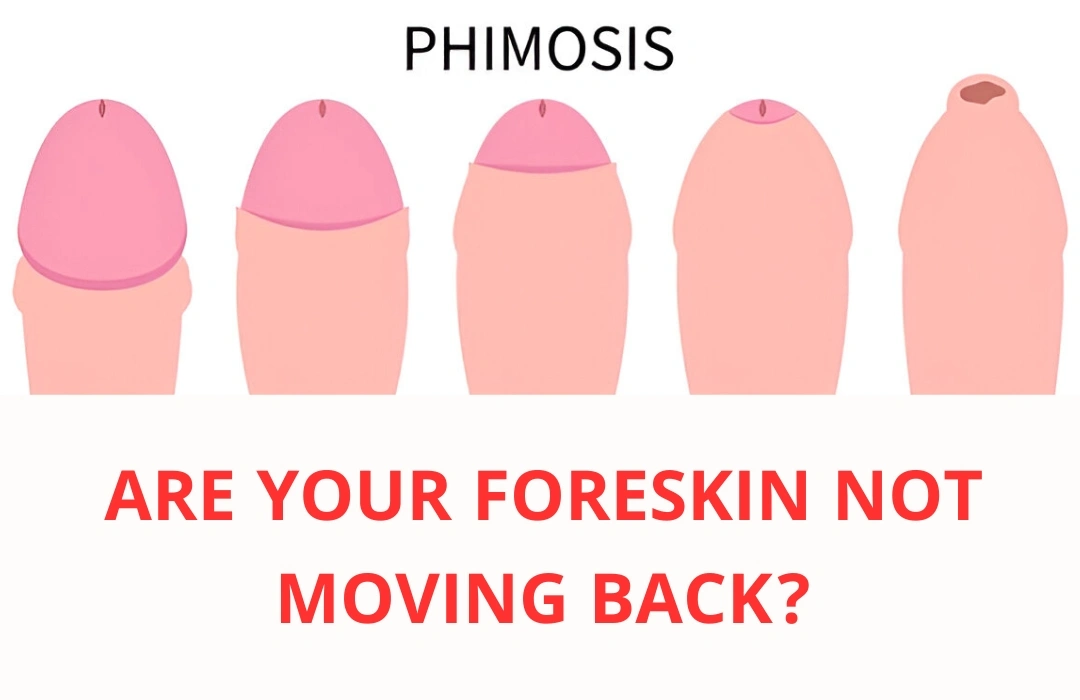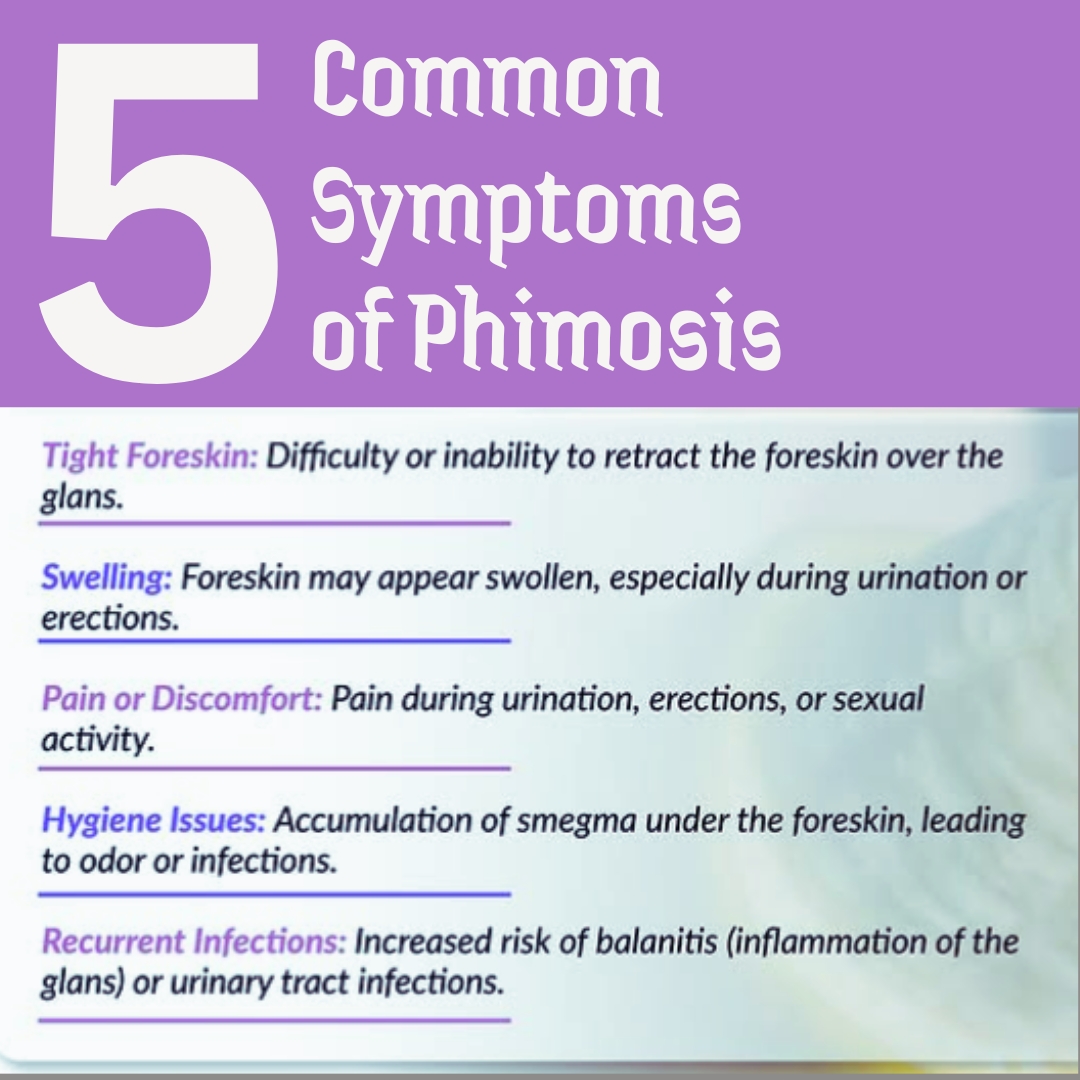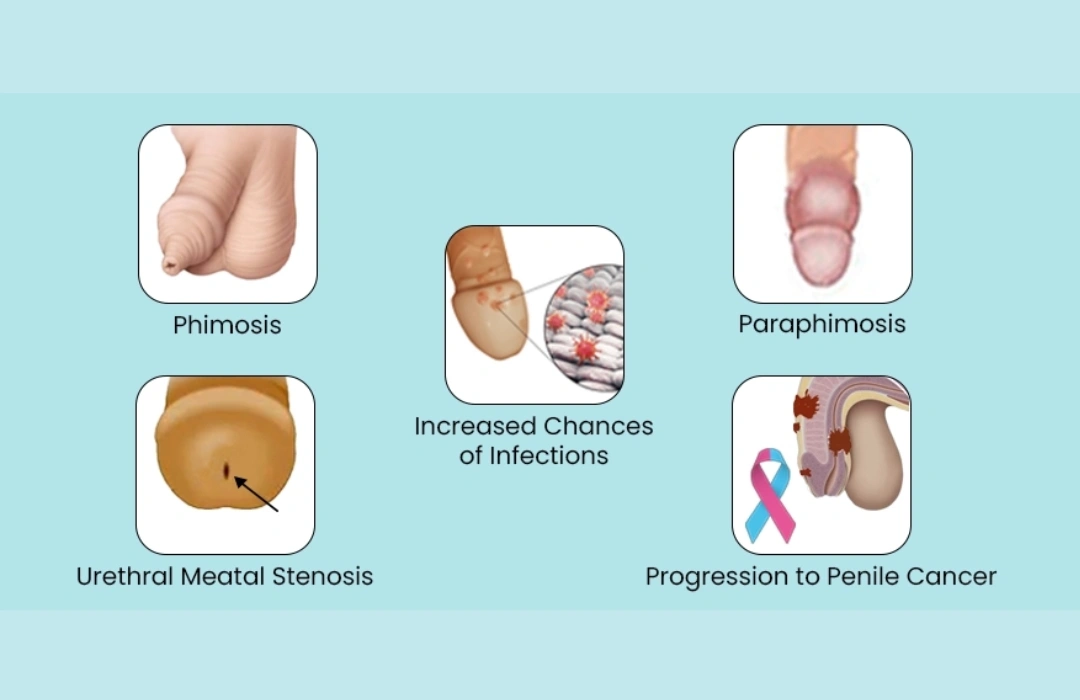Best Phimosis Treatment in Delhi
If the foreskin of your penis does not move even when you move it back and forth, do not panic, it gets cured with treatment.
Phimosis is a condition where the foreskin of the penis can't be pulled back fully. There are several ways to treat it, depending on how severe it is. For mild cases, doctors often suggest gentle stretching exercises to help loosen the foreskin. They might also recommend using steroid creams to reduce swelling and make stretching easier. If these methods don't work, or if the condition is more serious, surgery might be needed. The most common surgery is called circumcision, which removes the foreskin completely. Another option is a partial cut in the foreskin to make it looser. In some cases, doctors might use special tools to widen the foreskin opening without surgery. It's important to talk to a doctor to find the best treatment for each person's situation.

Types of Phimosis
Phimosis can be classified into two main types based on its cause and severity:
- Physiological
- Pathological
Physiological phimosis is common in infants and young boys and is considered a normal developmental condition. In most cases, it resolves on its own by adolescence without causing pain or complications. On the other hand, pathological phimosis arises due to underlying issues such as scarring, infection, or certain medical conditions. This type can affect males of any age, including adults, and often requires medical attention for proper treatment.
Causes of Phimosis
Phimosis can have several underlying causes, particularly when it progresses from being a natural condition (physiological phimosis) to a medical concern (pathological phimosis). While physiological phimosis is normal in children and usually resolves on its own as they grow, pathological phimosis requires attention. Here are the common causes:
Causes of Pathological Phimosis
- Skin Conditions: Certain skin diseases, such as lichen sclerosus, lichen planus, eczema, or psoriasis, can affect the foreskin and lead to phimosis.
- Injuries or Tears: Damage to the penile area, including small tears on the foreskin, can result in scarring and tightening over time.
- Aging and Reduced Sexual Activity: As men age, the elasticity of the foreskin can decrease, especially with reduced sexual activity, leading to difficulty retracting it.
- Infections: Sexually transmitted infections (STIs) or other infections can cause inflammation and scarring, contributing to phimosis.
- Diabetes: High blood sugar levels can create a favorable environment for infections, which may lead to phimosis.
- Scar Tissue Formation: Scar tissue, known as preputial adhesions, can form when the foreskin becomes attached to the glans, restricting movement.
- Poor Hygiene: Inadequate cleaning of the penile area can lead to infections and inflammation, worsening phimosis. Conversely, discomfort or pain caused by phimosis may discourage proper hygiene, creating a cycle of irritation and infection.

Symptoms of Phimosis
Phimosis can cause several symptoms that affect daily activities and overall well-being. Some common symptoms of phimosis include:
- Difficulty retracting the foreskin: One of the most common symptoms of phimosis is the inability to retract the foreskin fully or partially. This can make it difficult to clean the area properly, leading to hygiene issues.
- Pain or discomfort: Some individuals with phimosis may experience pain or discomfort when attempting to retract the foreskin. This can be due to inflammation or the tightness of the foreskin.
- Redness and swelling: Inflammation of the foreskin, known as balanitis, can occur in cases of phimosis. This can lead to redness, swelling, and tenderness around the opening of the foreskin.
- Urinary problems: Severe phimosis can cause difficulties with urination. This can include a weak urine stream, spraying or ballooning of the urine stream, or dribbling after urination.
- Infections: Due to the difficulty in cleaning the area properly, individuals with phimosis may be more prone to developing infections. This can present as recurrent urinary tract infections or infections of the foreskin and glans, such as balanoposthitis.
- Pain during sexual intercourse: Phimosis can cause discomfort or even pain during sexual intercourse because the tight foreskin may not retract fully, causing friction and discomfort.
Risks of Delay in phimosis Treatment

Delaying treatment for phimosis can lead to several risks and complications. Phimosis, a condition where the foreskin cannot be fully pulled back over the head of the penis, can cause pain and discomfort if left untreated. Over time, it may result in infections, as trapped bacteria can grow under the foreskin. Urinary problems can also occur, making it difficult to empty the bladder completely. In some cases, the tight foreskin can cause painful erections and interfere with sexual activity. There is also a risk of paraphimosis, a medical emergency where the foreskin gets stuck behind the head of the penis, cutting off blood flow. Additionally, untreated phimosis may increase the risk of certain types of penile cancer. Seeking timely medical attention and following the recommended treatment can help avoid these potential complications and improve overall quality of life.
Phimosis Diagnosis
Diagnosing phimosis is typically a straightforward process that involves several steps in order to accurately assess the condition. Typically, a doctor will begin by having a discussion with the patient regarding their symptoms and reviewing their medical history. This helps the doctor to gain a better understanding of the patient's overall health and potential underlying causes of phimosis.
Following the initial discussion, the doctor will then proceed to perform a physical examination of the affected area. This examination may involve visually inspecting the foreskin, looking out for any signs of tightness or difficulty retracting the foreskin. The doctor may also gently try to retract the foreskin to evaluate any potential pain or resistance.
In some cases, additional tests may be recommended to further evaluate the severity of the condition or to rule out any underlying medical conditions. These tests may include urine analysis, swab tests, or blood tests to assess for infections or other potential causes of phimosis.
Overall, diagnosing phimosis involves a combination of discussions, medical history review, and a physical examination of the affected area. This comprehensive approach helps the doctor to accurately diagnose phimosis and develop an appropriate treatment plan for the patient.
If phimosis frequently occurs no need to feel embarrassed or hesitate to talk with doctor. Open communication with doctor is key to receiving the right care and treatment.
Phimosis Treatment: Effective Solutions for a Healthier Life
Phimosis can be effectively treated by a sexologist in a comfortable outpatient setting. The treatment approach is tailored to your specific needs, considering the severity of your condition, the symptoms you're experiencing, and your personal preferences.
What to Expect During Treatment
- Customized Care: At Dr. Monga's, our doctor will identify the underlying cause of phimosis and recommend the best solution for your lifestyle.
- Non-Surgical Options: Mild cases are often managed with medicated creams, stretching exercises, or other non-invasive methods. Our team of expert counselors is here to guide you and provide personalized support to help you perform these exercises effectively.
- Advanced Procedures: For more severe cases, procedures like circumcision or preputioplasty may be suggested to provide long-term relief.
Why Choose Professional Treatment?
Ignoring phimosis can have negative consequences on your daily life, causing discomfort, infections, and potential complications. Fortunately, seeking help from a skilled sexologist can provide you with expert guidance and care in a stress-free environment.Don't allow phimosis to impact your overall well-being. Take the initial step towards a pain-free and confident life by scheduling a consultation today.
Phimosis Treatment: Non-Surgical and Surgical Options
Phimosis is a treatable condition with various effective solutions available. Whether you’re seeking non-surgical methods or exploring surgical options, the right treatment plan depends on the severity of your condition and personal preferences.
Non-Surgical Treatment for Phimosis
Young children often don't need treatment for phimosis, as the foreskin naturally loosens over time. However, you can take steps to encourage this process:
- Gentle Stretching: Regular, gentle retraction and stretching of the foreskin during bath time can help over time. Ensure it's done without causing any pain or discomfort.
- Medicated Creams: Steroid-based creams or ointments, such as betamethasone, fluticasone propionate, hydrocortisone, or triamcinolone, are highly effective. These creams soften and loosen the skin, making it easier to retract the foreskin. For best results, these treatments are often combined with stretching exercises.
When Surgery Becomes Necessary
If non-surgical methods are ineffective, surgical options are available to resolve phimosis permanently:
- Foreskin Incision: Small cuts are made in the foreskin to improve its flexibility and allow retraction.
- Circumcision: In cases of recurring infections, significant scarring, or conditions like balanitis xerotica obliterans, circumcision may be the recommended solution. This procedure removes the foreskin entirely, providing a long-term fix.
How Ayurveda Treats Phimosis
Ayurveda, an ancient system of medicine originating in India, views phimosis as a condition caused by an imbalance in the doshas, or energies, of the body. According to Ayurveda, phimosis may be caused by an excess of the pitta dosha, which represents fire and heat in the body.
To address the imbalance, Ayurvedic practitioners recommend a combination of internal and external treatments. These treatments aim to reduce inflammation and promote healing in the affected area.
Internal treatments may include the use of herbal medicines such as triphala, a mixture of three fruits known for their detoxifying and anti-inflammatory properties. Triphala can be taken orally to cleanse the body and reduce inflammation. Other herbal supplements, such as guggulu and gokshura, may also be suggested to support the healing process.
External treatments for phimosis in Ayurveda often involve the use of herbal oils and creams applied to the affected area. These oils and creams are designed to moisturize the skin, reduce inflammation, and promote tissue regeneration. Some commonly used oils in Ayurvedic treatment for phimosis include sesame oil, coconut oil, and aloe vera gel. These natural substances are known for their soothing and healing properties.
In addition to herbal remedies, Ayurveda also emphasizes the importance of lifestyle changes to promote overall health and healing. This may include following a balanced diet, practicing stress-reducing techniques such as yoga and meditation, and maintaining good hygiene practices.
Ayurvedic treatments for phimosis should be carried out under the guidance of a qualified Ayurvedic practitioner. They will assess the individual's unique constitution and customize a treatment plan accordingly. Monitoring of progress and adjustments to the treatment plan may be necessary based on individual response.
Ayurveda offers a holistic and natural approach to addressing phimosis, focusing on the root cause and promoting overall wellness. By incorporating Ayurvedic principles and treatments, individuals with phimosis can experience lasting relief and improved quality of life.
Ayurvedic Herbs Used to Treat Phimosis
Ayurvedic treatment for phimosis often includes the use of powerful herbs such as Ashwagandha, Gokshura, Shilajit, Kesar (Saffron), Safed Musli, Shatavari, Varahi Kand, Malkangni, Jaifal (Nutmeg), and Gokhru Bada. These herbs can be consumed as oral capsules or applied topically as oils, depending on the recommended treatment plan.These herbs have been proven to promote sexual health, improve stamina, and enhance overall wellness. Not only do they effectively treat phimosis, but they also support reproductive health.
Why Choose Dr. Monga for Phimosis Treatment?
Dr. Monga is a trusted name in Ayurveda, offering some of the best phimosis treatments in Delhi. His clinic is staffed with expert Ayurvedic sexologists who specialize in treating phimosis through natural, holistic methods.
The team at Dr. Monga Clinic takes a personalized approach, first diagnosing the individual thoroughly to understand the underlying causes and severity of phimosis. Based on this, they suggest the most suitable Ayurvedic medicines or oils to treat the condition effectively.
In addition to offering highly effective treatments, the cost of phimosis treatment at Dr. Monga Clinic is affordable, thanks to the use of naturally sourced remedies.If you are searching for the best phimosis treatment near you, Dr. Monga Clinic in Delhi is the ideal choice for safe, natural, and affordable care.Call 8010977000 and Book Your Appointment today!
Meet Our Team
Our expert team combines Ayurvedic wisdom with modern medicine to offer safe, proven treatment for phimosis—without the need for surgery.
-

Dr. Yuvraj Monga
M.B.B.S, M.D Chief Consultant Physician & C.E.O. -

Dr. Jyoti Arora
B.A.M.S Chief Ayurveda Physician -

Dr. Manisha Rani
B.A.M.S Chief Ayurveda Physician -

Dr. Rupeender
B.A.M.S Chief Ayurveda Physician -

Dr. Faizan Siddiqui
B.A.M.S Chief Ayurveda Physician -

Dr. Vikash
B.A.M.S Chief Ayurveda Physician -

Dr. Nidhi Deshmukh
B.A.M.S Chief Ayurveda Physician -

Dr. Sunil Tomar
B.A.M.S Chief Ayurveda Physician -

Dr. Tinkle
B.A.M.S Chief Ayurveda Physician -

Dr. Amit
B.A.M.S Chief Ayurveda Physician
Frequently asked questions (FAQ's)
-
1 Is phimosis curable without surgery?
ANS: Yes, many cases of phimosis can be treated without surgery using medicated creams and simple stretching exercises. Dr. Monga offers expert guidance for non-surgical treatment options.
-
2 How do I know if I need phimosis treatment?
ANS: If your foreskin doesn’t retract fully, causes pain, or leads to hygiene or urination issues, it’s time to consult a specialist. Book an expert evaluation with Dr. Monga today.
-
3 Can Ayurveda permanently cure phimosis?
ANS: Yes, Ayurvedic treatment at Dr. Monga Clinic can offer long-term relief by addressing the root cause naturally—without surgery or side effects.
-
4 Which is better: circumcision or Ayurvedic treatment for phimosis?
ANS: Ayurvedic treatment is preferred for mild to moderate cases. It is non-invasive, affordable, and avoids surgical risks. Surgery is reserved for severe or recurrent cases.
-
5 What is the fastest way to treat phimosis?
ANS: Combining steroid creams with guided stretching exercises often yields quick results. For severe cases, minimally invasive surgical options are available at Dr. Monga Clinic.
-
6 Does phimosis affect married life or sex life?
ANS: Yes, untreated phimosis can cause pain during sex and emotional stress. Early treatment improves intimacy, confidence, and relationship satisfaction.
-
7 Can diabetes cause phimosis?
ANS: Absolutely. High blood sugar increases the risk of infections and tightens foreskin over time. Managing diabetes and treating phimosis together is key—Dr. Monga specializes in both.
-
8 How long does Ayurvedic treatment for phimosis take?
ANS: Ayurvedic remedies usually show noticeable improvement within 2–4 weeks, depending on severity and patient response. Personalized plans accelerate results.
-
9 Is phimosis treatment at Dr. Monga Clinic private and confidential?
ANS: Yes. Your consultation and treatment are completely private. Our team ensures a safe, judgment-free environment for your comfort and confidentiality.
-
10 How do I book a consultation for phimosis treatment in Delhi?
ANS: Simply call +91 8010977000 to speak with our team or schedule your appointment online. Dr. Monga’s clinic is your trusted destination for effective, natural phimosis care.

